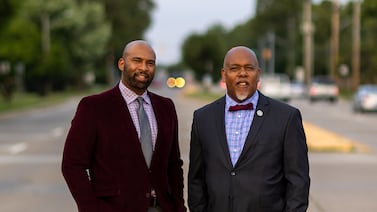Sign up for Chalkbeat Colorado’s free daily newsletter to keep up with education news in Denver and around the state.
Denver Public Schools students as a whole met goals the district set for math achievement but fell short in reading, according to a new report that measures academic and other progress against Superintendent Alex Marrero’s year-old strategic plan.
But the 20-page Annual District Report doesn’t break down test scores by student race and ethnicity, obscuring wide and persistent gaps between white students and students of color — gaps Marrero acknowledged in a presentation to school board members last week.
In an interview, Marrero said he was “incredibly encouraged” by the overall results. In the cases where DPS missed its goals, it was often only by a percentage point or two. The report also highlights that the district surpassed its graduation goal, posting a four-year graduation rate of 76.5% for the class of 2022, which was the highest ever in DPS.
“We’re trending in the right direction,” said Marrero, who was hired as superintendent in 2021. “When you’re shifting a major organization, you’re given grace for an implementation dip. Everything is new. If this is our implementation dip, good Lord, where we’re going to be.”
Some advocates have criticized the new report as spin. The higher test scores and graduation rates of white students from middle- and high-income families in DPS mask how the district is struggling to serve Black and Latinx students and students from low-income families, who make up the majority in the 89,000-student district, critics say.
“When you just release the totals, it gives a very different impression,” said Rosemary Rodriguez, co-chair of the advocacy group EDUCATE Denver and a former DPS school board member. “But when you break it down into subgroups, it’s not such a rosy picture.
“I think it’s important to be as honest as possible with as many people as possible so that we all can appreciate what’s going on with achievement in the district.”
A more detailed presentation Marrero gave to the school board last week shows that the district mostly missed its academic targets for Black and Latinx students in both reading and math.
The lack of progress perpetuates yawning gaps between the test scores of students of color and white students in DPS, which have been the largest in the state.
For example, state data shows 73% of DPS white students in grades three through eight met or exceeded expectations on state literacy tests this past spring, compared to 27% of Black students and 24% of Latinx students.
Similarly, the graduation rates for Black and Latinx students were 73% and 74%, respectively, for the class of 2022, compared to 86% for white students, according to state data.
Marrero’s strategic plan, which he released last year, listed several goals he hoped DPS would accomplish by the year 2026. The plan did not include incremental annual benchmarks. But the just-released report does, at least for last school year and this school year. The goals in the report are different from the goals the school board will use to evaluate Marrero’s performance.
Here’s a snapshot of how DPS is measuring up, based on the data in the new report and the presentation Marrero gave to the school board.
Goal: 62% of all kindergarten through third grade students would score at grade level or above on reading tests in spring 2023. By spring 2026, the goal is 70%.
Result: Not met. 58% scored at grade level or above in spring 2023.
Goal: 40% of all third through fifth grade students would meet or exceed expectations on state literacy tests in spring 2023. By spring 2026, the goal is 48%.
Result: Not met. 39% met or exceeded expectations in spring 2023.
Goal: 28% of all sixth through eighth grade students would meet or exceed expectations on state math tests in spring 2023. By spring 2026, the goal is 36%.
Result: Met. 28% met or exceeded expectations in spring 2023.
Goal: 26% of Latinx students in third through fifth grade would meet or exceed expectations on state literacy tests in spring 2023. Neither the report nor the presentation includes a goal for 2026.
Result: Not met. 23% met or exceeded expectations in spring 2023.
Goal: 15% of Latinx students in sixth through eighth grade would meet or exceed expectations on state math tests in spring 2023. Neither the report nor the presentation includes a goal for 2026.
Result: Not met. 13% met or exceeded expectations in spring 2023.
Goal: 26% of Black students in third through fifth grade would meet or exceed expectations on state literacy tests in spring 2023. Neither the report nor the presentation includes a goal for 2026.
Result: Not met. 24% met or exceeded expectations in spring 2023.
Goal: 16% of Black students in sixth through eighth grade would meet or exceed expectations on state math tests in spring 2023. Neither the report nor the presentation includes a goal for 2026.
Result: Met. 16% met or exceeded expectations in spring 2023.
Goal: 21% of English language learners in third through fifth grade would meet or exceed expectations on state literacy tests taken in both English and Spanish in spring 2023. Neither the report nor the presentation includes a goal for 2026.
Result: Not met. 17% met or exceeded expectations in spring 2023.
Goal: 22% of redesignated English language learners, meaning they no longer need ELL services, in grades six through eight would meet or exceed expectations on state math tests in spring 2023. Neither the report nor the presentation includes a goal for 2026.
Result: Met. 22% met or exceeded expectations in spring 2023.
The report and presentation also summarized results from new surveys the district conducted of students, families, and employees. For instance, 89% of families said they feel safe and welcomed in DPS, according to the presentation, and 52% of employees said they feel valued.
Melanie Asmar is a senior reporter for Chalkbeat Colorado, covering Denver Public Schools. Contact Melanie at masmar@chalkbeat.org.






